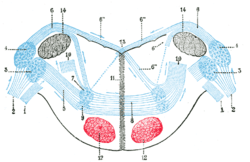Acoustic tubercle
| Acoustic tubercle | |
|---|---|
 Terminal nuclei of the cochlear nerve, with their upper connections. (Schematic.) The vestibular nerve with its terminal nuclei and their efferent fibers have been suppressed. On the other hand, in order not to obscure the trapezoid body, the efferent fibers of the terminal nuclei on the right side have been resected in a considerable portion of their extent. The trapezoid body, therefore, shows only one-half of its fibers—those that come from the left.
| |
| Details | |
| Latin | Tuberculum acusticum |
The acoustic tubercle is a nuclei on the end of the cochlear nerve.
The cochlear nerve is lateral to the root of the vestibular nerve. Its fibers end in two nuclei: one, the accessory nucleus, lies immediately in front of the inferior peduncle; the other, the acoustic tubercle, somewhat lateral to it.
References
This article incorporates text in the public domain from the 20th edition of Gray's Anatomy (1918)
External links
This article is issued from Wikipedia - version of the 10/3/2016. The text is available under the Creative Commons Attribution/Share Alike but additional terms may apply for the media files.